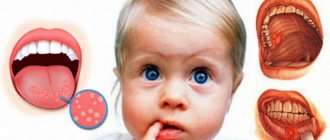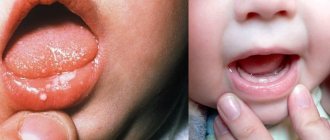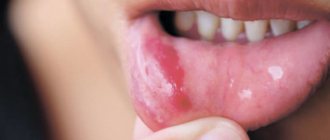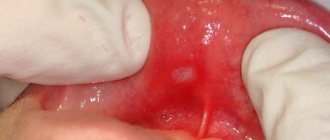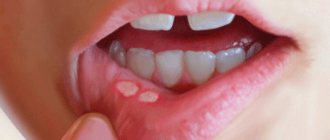Causes and risk factors
The mucous membrane of the child's oral cavity is often injured. The appearance of ulcers can be caused by temperature effects (hot food and drinks), biting the inner surface of the cheeks or lips; damage by sharp edges of the filling, braces or the tooth’s own tissues in case of chipped enamel. Normally, the immune response allows the pathological process to be quickly eliminated, the mucous membrane heals, and bacteria do not have time to cause severe inflammation and ulceration.
Weakened children's immunity cannot cope with this task, which leads to the development of aphthous stomatitis. A small number of opportunistic bacteria that populate the oral cavity begin to actively multiply. Often the disease occurs against the background or as a result of a severe infection: influenza, ARVI, acute tonsillitis, infectious mononucleosis, etc.
Main risk factors:
- food allergies, allergic reactions to hygiene products, such as toothpaste;
- deficiency of vitamins and microelements due to a strict diet or impaired digestion of food;
- hereditary predisposition;
- foci of infection in the oral cavity: caries, chronic periodontitis, periodontitis, gingivitis;
- frequent respiratory diseases;
- severe systemic diseases: pathologies of the endocrine system, blood vessels, metabolic disorders, etc.
Ask a Question
Causes
- Malfunctions of the immune system
- Diseases of the gastrointestinal tract
- Hereditary factor
- Allergies to certain foods and medications
- Avitaminosis
- Unbalanced diet (lack of vitamin B12, folic acid, iron in the diet)
- Tonsillitis, sore throat, pharyngitis
- Local infection with pathogenic microflora (from diseased teeth and gums or from external sources)
- Injury to the mucous membrane (burns, biting, injuries from sharp edges of fillings or braces, etc.)
Forms of the disease
According to the ICD, aphthous stomatitis is assigned code K12.0. There are two forms of the disease - acute and chronic. The second is characterized by frequent relapses and may be a consequence of inadequate or untimely treatment of acute inflammation.
An acute disease is characterized by severe symptoms. It begins quickly, severe pain occurs at the site of mucosal damage, and the child may refuse to eat. In some cases, body temperature rises, weakness and lethargy occur.
The chronic form is characterized by a sluggish course; the child’s general well-being does not suffer. The disease can recur up to several times a year.
Folk remedies
Folk remedies are usually used during follow-up treatment, when acute manifestations are eliminated.
For the treatment of stomatitis the following is used:
- infusion of chamomile flowers;
- paste from ground burdock seeds with salt and butter;
- decoction of oak bark;
- aloe juice;
- a decoction of the rhizome of snakeweed;
- yarrow decoction;
- infusion of ground rhizome of bergenia;
- infusion of pomegranate peel.
Physiotherapeutic agents include treatment of lesions with ultraviolet rays.
Symptoms of aphthous stomatitis
The onset of acute aphthous stomatitis in children may resemble ARVI: there is malaise, increased body temperature, and more profuse salivation may appear. The main symptom of the disease is the appearance of ulcers in the mouth: first, a red dot appears on the mucous membrane, which subsequently becomes an ulcer (aphtha) within 2-3 days. Accidental touching causes pain. The child refuses food and hygiene procedures.
Single erosions occur more often, but there are cases of multiple aphthae formed in groups. They usually measure up to several millimeters, but in severe cases the diameter of the ulcer reaches one centimeter. The disease is characterized by the appearance of a bright red rim around the aphthae; a grayish or yellow film-like coating forms on it.
There are also general symptoms that accompany aphthous stomatitis. These include:
- sleep disturbances (due to pain or discomfort);
- decreased appetite;
- pain while talking;
- increased fatigue, lethargy;
- whims, irritability.
Early treatment of aphthous stomatitis in children can prevent complications, shorten recovery time, and prevent further development of the disease.
Kinds
Fibrous. Oral aphthae are formed against the background of impaired blood microcirculation in the oral mucosa; they are characterized by a peculiar plaque, which is a fibrous film. Such ulcers heal in up to two weeks; relapses may occur every 3-4 months.
Necrotic. With this type, areas of the epithelium are destroyed, and therefore areas of the mucous membrane die off. Tissue restoration takes from two weeks to a month. As a rule, this type of aphthous stomatitis does not cause serious pain, representing a concomitant symptom of serious illnesses, incl. blood pathologies.
Granular. The course of the disease includes damage to the ducts of the salivary glands. Forming close to them, oral aphthae block the formation of saliva, drying out the mucous membrane. In this regard, wounds and ulcers heal worse and cause sharp pain when moving, eating, or talking. Healing takes from a week to three.
Scarring. An even more complex form, in which damage to the salivary glands is followed by inflammation at the level of connective tissue. Aphthae are located everywhere in the mouth: near the glands themselves, on the mucous membrane of the palate and pharynx, reaching 15 millimeters in size and above, and are very painful. After healing, which takes about three months, noticeable scars remain.
Deforming. The most severe type of aphthous stomatitis, which causes deformation of the connective tissue of the oral cavity. Such aphthae take a very long time to heal, the lips and palate can change their shape; in particularly advanced cases and if aphthae develops in the corners of the lips, even a narrowing of the mouth opening is possible.
How and with what to treat aphthae in the mouth directly depends on the type of disease, but only a professional doctor with practice can determine it!
Features of treatment
To diagnose a disease, only a visual examination is often sufficient, but in some cases laboratory diagnostics are required to determine the causative agent of the inflammatory process and the sensitivity of bacteria to antibiotics. Treatment should be carried out by a dentist, and the treatment regimen is developed individually, taking into account test results, the age and well-being of the child, the causes of the disease, the area of mucosal lesions and other conditions.
If the question of how to treat aphthous stomatitis in children is decided individually, then recommendations regarding eating behavior and hygiene are general for all cases. Such recommendations include the following:
- avoidance of too hot or cold drinks and foods;
- following a hypoallergenic diet;
- refusal of food that irritates the mucous membrane. This list includes fatty, salty and spicy foods, marinades, solid foods;
- adding pureed and soft foods to the menu. This includes cream soups, porridges, pre-boiled meat;
- drinking enough liquid;
- careful adherence to oral hygiene: using brushes with soft bristles, rinsing the mouth after each meal.
Local drug treatment consists of the use of such agents as:
- rinses or irrigation solutions (for children who do not yet know how to rinse their mouths) with an antiseptic effect;
- ointments and gels that stimulate the restoration of mucous membranes;
- drugs for pain relief and burning sensation.
It is important to test the product before use: apply a small amount to the crook of your elbow. If there is no redness, burning, or rash, we can say there is no allergy - the product can be used for treatment.
In some cases, systemic drug therapy is indicated. Your doctor may prescribe antihistamines to combat the allergic reaction and relieve swelling. In order to increase the resistance of the child's body, immunomodulators may be recommended. The decision on the need for antibacterial therapy is made in the case of an extremely severe course of the disease, a persistent increase in body temperature, and identification of a bacterial pathogen in a smear.
Elevated body temperature and pain are indications for symptomatic therapy. The doctor may recommend non-steroidal anti-inflammatory drugs in a dosage and form appropriate to the age of the young patient. Sometimes it is advisable to use suppositories if taking the medicine in the form of a tablet or syrup causes pain or anxiety.
Treatment of infants additionally includes disinfection of toys and teethers that the baby may put in his mouth. A nursing mother should pay attention to breast hygiene: thoroughly wash her breasts after feeding using warm water and special products.
Sometimes it is advisable to use folk remedies. Thus, rinsing the mouth with chamomile can soothe inflamed mucous membranes and speed up the healing process. However, it is important to remember that such prescriptions can only complement the main course of treatment. Don't forget to consult your doctor about the possibility of using them. Some herbs are strong allergens, so it is important to ensure that you are not hypersensitive to them.
Warming, the use of honey and alcohol tinctures are prohibited, as all this can lead to a worsening of the condition and lead to serious complications. It is better not to self-medicate, but to show the child to a qualified specialist.
Treatment of aphthous stomatitis in children usually takes no more than 7–12 days. It all depends on the state of the child’s immune system, the severity of inflammation, the number and depth of ulcers.
Mouth treatment
The most effective measures for treating the disease are rinsing with physiological antiseptics and irrigating the oral cavity with anti-inflammatory sprays.
For treatment of the oral cavity they are used;
- miramistin solution;
- 0.06% chlorhexidine solution;
- 0.02% solution of furatsilin;
- 0.1% dimexide solution.
During therapy, it is important to select medications that provide a quick cure.
The following medications are used for therapy:
- application of anesthetics with proteolytic enzymes for 10-15 minutes once a day (trypsin, lysozyme, ribonuclease);
- applying epithelializing ointments to ulcers (Solcoseryl-gel);
- rinses with antibacterial drugs: Tantum-Verde in a dosage of 15 ml 3-4 times a day, 5-6 days or use Hexoral, Orasept;
- applications of Mundizal gel to the oral mucosa for 20 minutes 3-4 times a day, 5-10 days;
- balm Stomatofit-A, it contains painkillers, extracts of medicinal plants;
- antifungal drugs;
- painkillers, anti-inflammatory ointments (Benzocaine, Xicaine);
- Diphenhydramine suspension to relieve allergic symptoms.
Prevention
The development of the disease can be prevented with the help of general strengthening measures: it is important to adhere to a daily routine, provide nutrition taking into account the body’s needs for vitamins and minerals, and pay attention to the prevention of infectious diseases.
The development of stomatitis can be avoided using simple measures, such as:
- regular oral hygiene, which should begin from the moment the baby’s first tooth appears;
- use of toothpastes without sodium lauryl sulfate. This component increases the risk of developing the disease;
- routine examinations by a pediatric dentist;
- rinsing the mouth after every meal;
- limited consumption of sweets.
Pediatric dentists at STOMA clinics are ready to help a child of any age. By contacting us, you can be confident in the professionalism of our specialists. We have developed effective treatment regimens for aphthous stomatitis in children. Doctors will talk in detail about preventing relapses and give recommendations on maintaining oral health.
Diagnostics
Aphthous stomatitis is a dental disease, so the right decision would be to seek help from a dentist. For quality treatment, diagnostics are required.
The main method of collecting anamnesis is interviewing the child and parents about complaints, as well as examining the oral cavity. Considering how many features the disease can have, only a qualified and experienced specialist should treat a small patient.
After determining the clinical picture, possible causes and the presence of provoking factors, the doctor can draw up a treatment regimen.


